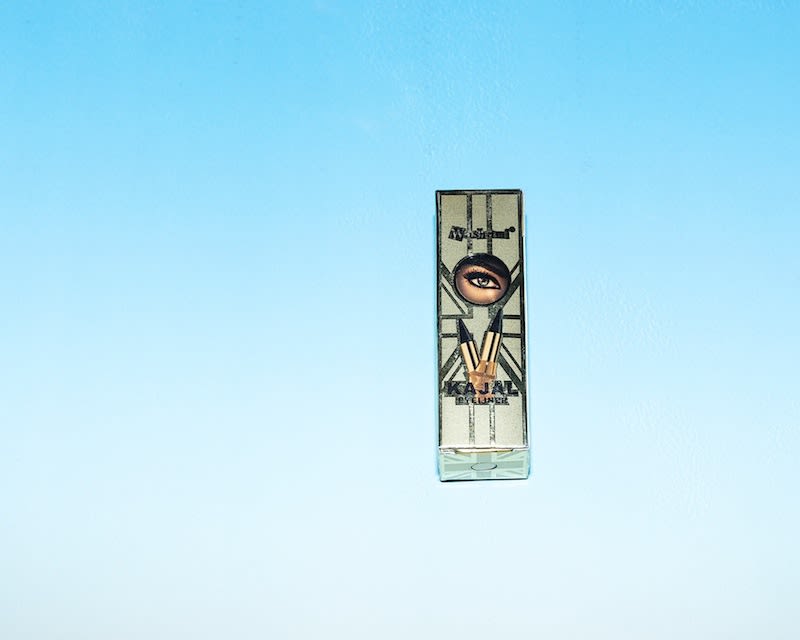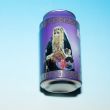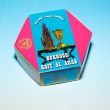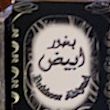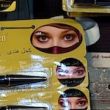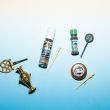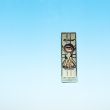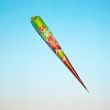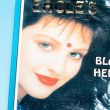In 2009, I moved to Doha, Qatar to teach English at an art & design branch campus of an American university. Qatar, for those unfamiliar with the country, shares a border with Saudi Arabia, and is best known for its incredible wealth, ambitious (and maligned) infrastructure growth, and its desire to become an international showcase for art, culture, and athletics (as of now, the 2022 World Cup is slated to take place there). Because the natural gas and oil reserves that boosted the country’s GDP and visibility were only discovered in the 1970s, this tiny peninsula has gone through rapid changes in a fairly brief period, creating very different cross-generational experiences for its citizens.
Qatar has long been a globalized country, a point of intersect for people of the Middle East, East Africa, and Asia. It was a British protectorate until 1971, and this influence, combined the three decades of wealth and travel have created a taste for high street luxury amongst the local population. But like any place in transition, a desire to return to the traditional, to what is purely ‘Qatari,' hangs as heavy in the air as the ever-present scent of burning oud.
Most of my students were either Qatari or from nearby Middle Eastern and Asian countries, and many shared a taste for designer handbags, shoes, and makeup. And, as I learned from discussions in the research-writing course I taught, even the minimalists in their ranks had strong opinions about cosmetics and dress. It made sense to me, this interest in self-expression, especially in a country where women typically wear the national dress of black abayas over street clothes in public (and men wear perfectly pressed thobes). In this class, my students came up with their own topics for the 10-page paper, and every semester I taught it there were always several proposals related to beauty in the mix. Over time, I started to think about how I would tackle the subject, if I were to write about it, and always returned to my fascination with makeup found in the souq.
Souq Waqif is Doha’s version of Istanbul’s Grand Bazaar—a maze of alleys lined with shop fronts selling everything from strands of gulf pearls to bolts of fabric, kabobs to coffee mugs with cartoon camels. Mixed in with the expensive honey shops and gold sellers are stores filled with absolute junk—gray market goods from parts unknown. For my money, the makeup stalls among them were always the most fun, with cheap thrills abounding: kohls and kajals, hennas and lotions, each product packaged more outrageously than the last. I lived in Qatar for four years, and by the time I left I’d amassed a sizeable collection of unopened souq cosmetics, and a number of unanswered questions. If my students were loyal to Chanel and Inglot, who was buying Hashmi-brand kajal? Who was still using Tibet Snow? What follows are my discoveries in Souq Waqif’s traditional beauty shops:
KOHL/KAJAL
Also known as surma on the Indian subcontinent, this eyeliner has a centuries-old history. Predating pharaonic times in Egypt, there is evidence that it was worn by people of all ages and ranks. In parts of the Arabian Peninsula, ancient funerary rituals involved burying women with jewelry and kohl-filled seashells, for use in the afterlife. Passages recommend its use in the Quran—it is considered sunnah, an appropriate Muslim practice, for both sexes.
Kohl provided a number of health advantages: it cooled eyes in the desert sun, and kept them clean by trapping dust and dirt (some recent studies have also shown traditional kohl may have boosted the immune system by stimulating the production of bacteria-killing nitric oxide). The darker and glossier the kohl, the higher the quality, but these residual health and beauty benefits came at a price: lead poisoning. Kohls were toxic, made by melting lead sulfide with soot and grease. Today, many Middle Eastern and Asian-made kohls still contain significant amounts of lead, causing the FDA to place a ban on their import to the United States.
In Souq Waqif, the most well represented brand is Hashmi Kajal from Pakistan, sold in pot, tube, stick, and gilded vial form. The holographic packages are hung in strips against stall doors, and once you’ve torn off your selection, you strike a deal with the seller—an exchange that involves dramatic use of a calculator and often gets you a second product at a discount. Two for (almost) one!
The instructions on all of Hashmi’s products are technically intimidating: “Insert probe into paste and twist. Take out probe and apply into the eye.” But the pigment-dipped plastic stick is meant to be swiped along the waterline (as demonstrated by Daphne Hezard). Among my Arab friends, the consensus is that souq-found kohls are only used by either the very old, or the very traditional nowadays. Or: “they are bought by foreigners like you, who go crazy for the packaging.” Young Qataris are more apt to be seen at MAC, buying Fluidline, for reasons that have as much to do with status and modernity as they do with health and safety. Still, the aesthetic remains: striking, dark-rimmed glances are practically the only kind you get in Qatar.
If you’re in search of approved kohl equivalents in America, here are some options: Guerlain Terracotta Loose Powder Kohl Liner, or ‘Khol Me Kajal’ Eyeliner, Himalaya Kajal Herbal Eye-Definer.
HENNA
One day in class, while I was giving a lesson on thesis statements or something of the like, a student pulled a bottle of nail polish out of her purse, and began whispering to a friend seated next to her. I balked, and received an innocent eyelash flutter in return. “But Miss,” she said. “This is a new brand I just found in London. It’s halal nail polish.”
I had no idea nail polish could be halal. “Tell me more,” I told her, because like any good professor, I try to be on the lookout for authentic teachable moments. Turned out, she was right— Inglot, has by some miracle/accident of chemistry, made a nail polish that allows water to reach the nail, which is essential for proper wudu—the cleansing procedure done before prayer. Prior to Inglot, if Muslim women wanted to be truly faithful, they would have to relegate their manicures to the days they were menstruating, and that could get embarrassing, so my students said.
Henna is totally halal, the proto-nail polish of the Islamic world. Naturally occurring (the paste is made from leaves of the henna shrub), it stains the body, rather than coating it. It is also sunnah; the Prophet Muhammad prescribed its use on nails and as hair dye. My friend, Haya, explained the idea further to me: “It’s actually part of the religion to keep yourself looking nice, to stay fit, to dye your gray hair. You do it for your husband or wife.”
Some historians link the average three-week duration of henna’s stain to fertility. It is thought that in the past, henna would be drawn on a woman’s skin at the end of her period and fade over the course of her cycle. Like crib notes for baby-making, a husband would be able to tell if his wife was fertile by the shade of her tattoo.
Today in Qatar, henna is done for special occasions: weddings, holidays, and festivals. Arabic motifs are often floral—more gestural than their geometric East African counterparts, larger than those hailing from points east (Nepal, Pakistan, Bangladesh, etc). In addition to henna’s cooling and calming properties (always a plus in the desert), its designs are endowed with spiritual power, or baraka. Henna patterns are believed to ward off evil, promote aforementioned fertility, establish good energy, and so on.
Typically, Qataris have henna applied in salons or at home by talented practitioners. In the souq, bags of powder and cones of paste are inexpensive, as are stick-on stencils (for the DIY-er). Thanks to public awareness campaigns in Qatar, the popular and dangerous black henna is more difficult to come by (its high concentration of a chemical called PPD has been known to cause disfiguring burns).
I’ve always been most curious about the small tubes of henna (Al Fizza and Al Rehan brands) meant to stain fingertips a rusty red color. In Doha, I saw this style most often on Somali and Sudanese women; in America, I see it now on TV and online—in the form of Lorde’s blackened Grammy fingers (inspired by Michele Lamy, inspired by…).
Like kohl, henna has faced some governmental roadblocks in the United States. The FDA does not approve its application on skin (hair dye is OK). But since states have authority over such matters, it’s not impossible to find it in specialty stores or salons. Just be responsible and do some research; inquire about the quality and origin of the products being used.
Some domestic henna/henna-substitute products: Rad Nails Cuticle Tattoos, LUSH Henna Hair Dyes.
MAGIC LIPSTICK
After attracting the attention of The Man Repeller, Hare Magic Moroccan lipsticks have become sought-after goods on eBay. In Souq Waqif, the equivalent brand for sale is Halet, rather than Hare, and they’re made in China. A pack of 12 costs about $7. When I presented the multi-colored tubes to my Qatari friends for inspection, a wave of nostalgia passed over them. “We had these when we were kids!” they said. Which is when I also remember experimenting with “mood match” lip color. They laughed when I suggested they should use them now, as adults. Then I tried a few on and found that they a) taste like gasoline b) are nearly impossible to wipe off, so I have to agree.
OUD/BUKHOOR
This is a souq sub-genre that could fill a book, so I’ll provide only a quick overview here. There is nothing I associate more readily with my time in Qatar than the scent of oud—a heady aroma derived from agarwood (a type of resin formed when certain species of evergreens are attacked by mold). Such trees are found throughout Southeast Asia, and the harvested oud is imported to the Gulf where thousands of riyals are spent on rare varieties. Though these scents constantly surrounded me abroad, I remain a novice when it comes to their subtleties. This I do know: mamool is incense in stick or woodchip form, while bukhoor is pressed bricks infused with oil. Both are burnt in a mabkhara, and are an important part of hospitality traditions in Qatar.
The cheap ouds sold in the souq might not be of the highest quality, but they do have the most fantastic containers. A curious score of mine is a purple screw-top soda can filled with Mamool Bint Al Arab (Arabian Daughter Incense). Another favorite is the brightly colored Bukhoor Bait Al Arab (Incense for the Arabian Home). These days in America, when I’m feeling particularly Qatar-sick, a whiff of one of these beauties always does the trick. And then leads directly to a headache.
Ouds are not new ITG territory, so for further reading pleasure, check out The New Ouds, *Accord Oud by Byredo](http://intothegloss.com/2011/01/accord-oud-by-byredo/).
In the miscellaneous “toiletries' category, I’d like to mention a few MVPs of the Arabian toilette. They are as follows…
MISWAK
Another ancient, sunnah-appropriate product, miswak is a twig that’s used to clean teeth. It comes from the arak tree and today can be bought in individually packaged, vacuum-sealed bags. To prepare the miswak, you scrape the bark off the end of the stick, exposing the soft and pliable wood beneath. This is chewed until the fibers separate to form bristles, and is then used like a toothbrush.
The Indian Ayurvedic company, Dabur, sells toothpaste made with miswak extract, available through Amazon. It retains the antibacterial properties of the arak wood, but is meant to be used with synthetic toothbrushes.
CLEOPATRA SOAP
Originally manufactured by Palmolive as a lotion soap competitor to Dove, Cleopatra has a troubled past. Its marketing campaign is often used by business schools as a case study in worst practices—after Palmolive successfully released the soap in France in the 1980s, they poorly released it in Canada and the United States by pricing it too high and failing to adapt their advertising strategy to the North American market. It was unpopular and eventually discontinued.
Now, almost 30 years later, Cleopatra enjoys a strong customer base in the Gulf, distributed by Saudi-based Colgate-Palmolive Arabia. I discovered the “Now Even Creamier” variety in Doha, and have since been loyal to its garish metallic wrapper and moisturizing lather, in spite of the somewhat cloying scent. A multi-pack of Cleopatra made its way into my suitcase when I returned home to the States and friends abroad have been kind enough to replenish my supply by post.
TIBET SNOW
Ubiquitous Tibet Snow, found throughout the souq and in the supermarkets of Doha, is a Bangladeshi import. Though it’s described as “an exquisitely perfumed skin tonic,” it closely resembles Pond’s Cold Cream in consistency and scent. An ad insert claims that “school & college girls” love it, as do “sportsmen,” and recommends its use on everything from corns to underarms. My boyfriend would get $3 haircuts and straight razor shaves at the souq barbershop, where a brisk pat of Tibet Snow was always the finishing touch.
While skin-whitening promises add a dubious edge to its charm, Tibet Snow has (in my opinion) the most beautiful packaging of all the beauty products in all the world.
There are many lessons to be learned from these souq finds; they say so much about history and the exchange of cultures in Qatar. But I keep returning to the appearance of the products themselves—they may speak of tradition, but they look like fun. That’s a valuable takeaway for purveyors of luxury worldwide.
—Lauren Maas
*Lauren Maas](http://into.gl/1hbo271) is an Austin-based writer who recently returned to America after four years of teaching in Doha, Qatar. She also co-edits the Richmond, VA-based literary journal, Makeout Creek. Photos by Sarah Lauck.


